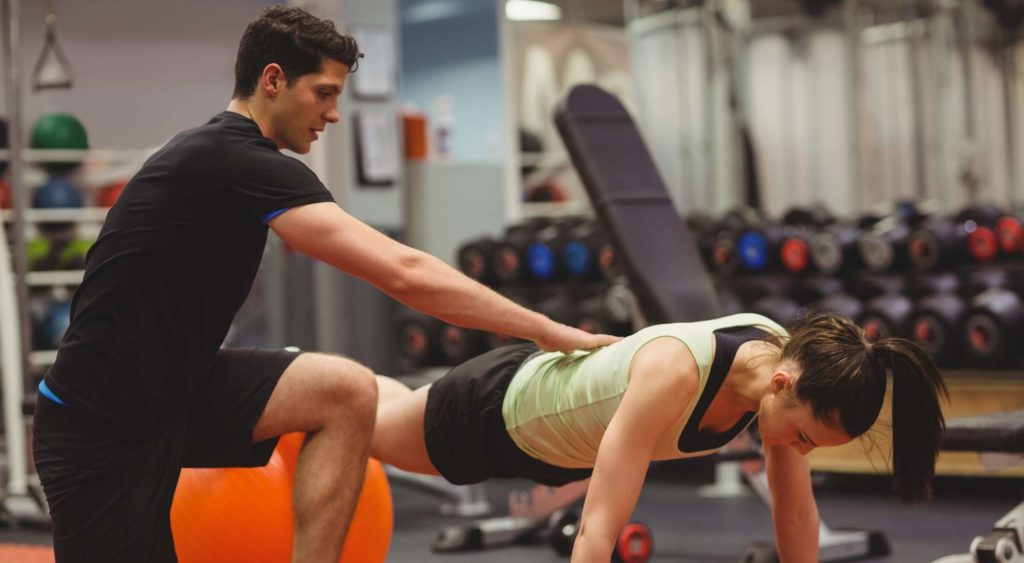
You arrive at the gym and head to the weight room.
You glance around the room and see the barbells and benches, the dumbbells, and the weight machines.
You’re overwhelmed.
You’re not sure where to start.
Weight training can be daunting if you’re not sure what you’re doing, or what your goals are. And without a plan, you’re wasting your time. Without a plan, you won’t see progress when it comes to strength training.
Whether you’re a beginner who rarely picks up a dumbbell or a seasoned lifter simply looking for guidance on exercises to combine in your lifting program, this guide has the answers.
Working Out The Open Chain vs. Closed Chain
When it comes to muscles and weight training you’ve probably heard about upper body vs. lower body exercises. Or you may have heard of ‘the big four’ muscle groups:
- Chest
- Legs
- Back
- Abs
But it wouldn’t be surprising if you haven’t heard of:
Open chain exercises are exercises that are performed where the hand or foot is free to move.
Conversely, closed chain exercises are performed with the hand or the foot fixed (not moving). The hand or foot remains in contact with an immobile surface (the ground or base of a machine) during the movement.
You may be wondering, “should I be targeting open or closed chain exercises?”
There are advantages to both.
Open chain exercises are better for isolating a specific muscle, while closed chain exercises offer more functional athletic benefits because the movements often engage more muscle groups.
Many fitness coaches, trainers, and physical therapists recommend a combination, as both are effective for strengthening and rehabilitation.
Edgar, In Motion O.C.’s Director of Fitness, says:
“Once you come into the gym, fitness trainers can show you better than tell you what working these two different muscle chains feels like.”
If you’re someone who learns by doing, set up a consultation today. You’ll learn more in just a few minutes with one of In Motion O.C.’s fitness coaches showing you how to work different muscle chains than you would in a few hours of reading about it.
What Exercises Are Considered “Open Chain?”
Open chain exercises are ideal for physical therapy and rehabilitation following an injury because they can isolate and target specific joints, muscles, and even specific heads of certain muscles at different phases of contraction.
Examples of open chain upper body exercises include:
- Biceps curl
- Lying triceps extension
- Bench press
- Lat pull-down
- Chest fly
Examples of open chain lower body exercises include:
- Seated leg extension
- Leg curl
- Calf raises

What Exercises are Considered “Closed Chain?”
Closed kinetic chain movements promote joint stabilization. They also engage and exercise more than one muscle group simultaneously rather than concentrating solely on one—as many open kinetic chain exercises do.
These exercises are typically weight-bearing exercises, meaning you’ll use either your body weight or external weights.
Examples of closed chain upper body exercises include:
- Push-ups
- Pull-ups
- Dips
Examples of closed chain lower body exercises include:
- Squats
- Deadlifts
- Lunges
- Power cleans
- Hip bridges
- Wall slides
What Muscle Groups Should I Be Working Out Together?
When people are interested in beginning a strength training program, they often head online. A quick Google search for “weight training plan” brings up more than 793 MILLION results.
Not exactly helpful.
Where should you start?
A full-body workout? A body-part routine? Powerlifting? Bodyweight training? The possibilities are endless.
But, people have different
- Goals
- Fitness levels
- Lifestyles — including the amount of time available for working out
This means — there’s no “one-size-fits-all” weight training plan.
Look At The Movement vs. Muscle
Many people divide weight training in terms of muscle groups, meaning they break up their strength training workouts by lifting certain parts of the body on certain days.
Arms on Monday. Chest and back on Tuesday, etc. You’ve likely heard someone complaining about being sore after “leg day.”
Training different body parts on different days isn’t wrong, but it isn’t the only way.
Our fitness coaches recommend looking at the movement of your body rather than solely focusing on the muscle when it comes to strength training.
Edgar, In Motion O.C.’s Director of Fitness, says:
“Personally, I think you can train any muscle with any muscle as long as there is a balance on both sides of the joint. If you are pushing, you should also be pulling.”
Push-Pull Strength Training
Edgar goes on to say:
“You have to look at more of the movement as opposed to the muscle when deciding what muscles to train. So during a session, if our clients are going to be pushing by doing a press, we will pair that with a pulling exercise in a non-competing muscle.”
It’s pretty simple when you think about it — push exercises contract your muscles when weight is pushed away from your body while pull exercises contract muscles when weight is being pulled toward your body.
Examples of push exercises include:
- Push-ups
- Squats
- Bench press
- Shoulder press
Examples of pull exercises include:
- Pull-ups
- Rows
- Biceps curls
- Lat pull-downs
Benefits of Push-Pull Strength Training
Push-pull strength training is an effective and safe way to get a complete workout. By including both pushing and pulling exercises, you target nearly every muscle in your body.
Other benefits of this method are:
- Muscle balance
- Injury prevention
- Time-saving
- Improved posture
Muscle Balance
Dividing muscle groups into different workout days can lead to imbalance. If you perform exercises that are opposites of one another, you ensure balance.
Examples of this include:
- Chest press (push) and back row (pull)
- Squat (push) and deadlift (pull)
- Triceps kickback (push) and biceps curl (pull)
Injury Prevention
It’s easy to become injured when you overtrain individual muscle groups.
For example: Maybe you bench press every time you hit the gym, BUT you never include rows in your workout. You’re leaving your body unbalanced and may develop injuries in the shoulder joint as the stronger muscles overcompensate.
Balancing push and pull exercises ensures you don’t put too much stress on a single muscle. The more balanced your workout, the safer you’ll be.
Time-Saving
If you lift weights divided by muscle group, you’re committing to at least 4 days of strength training each week, if not more:
- Back
- Chest
- Legs
- Arms
By using the push-pull strength training method, you can do strength training in just 2 or 3 days each week by doing supersets (which means doing both push and pull exercises on each weight training day).
Improved Posture
Push-pull workouts improve posture and body alignment while increasing strength.
What Is Your Goal?
What are you hoping to achieve during your trips to the gym? What are you working toward?
In order to maximize the effectiveness of your strength training program, it’s important to know your goals.
When it comes to strength training goals, people are usually in one of two camps:
- Bulking up/building muscle
OR
- Toning muscle
Read on to learn how your goals impact your workouts.
Building Muscle
Are you working to build muscle?
This means increasing muscle mass. If this is your goal, lifting heavier weights is key. In order to ‘bulk up,’ you’ll want to strength train a minimum of twice each week.
Weights should be heavy enough that the final reps in each set are incredibly difficult.
If you’re looking to increase muscle mass, you’ll want to focus on exercises that work several muscles at the same time.
When you use multiple muscles simultaneously, you’ll be able to lift heavier weights.
These compound exercises include:
- Squats
- Deadlifts
- Bench presses
- Barbell rows
Lifting heavy weights is the key to hypertrophy which means more muscle growth.
In order to build muscle you’ll also need to:
- Give yourself plenty of recovery time
- Eat more/increase protein intake
- Be consistent in your weight training
Toning Muscle
When people talk about toned muscles vs. bigger muscles they’re usually referring to a long, lean musculature that looks strong but not bulky.
Body composition is a factor when it comes to a toned appearance. Toning is a matter of losing fat and building muscle.
When it comes to strength training for toning, you’ll want to complete reps quickly, with little rest in between sets.
What Muscle Groups Should Be Worked Out Together For Beginners?
You might be thinking … I’m new to all of this, I’ve never lifted weights before! Does this apply to me?!
The simple answer: Yes.
Being a beginner has no impact on the muscle groups or exercises to focus on.
Instead, as a beginner, the key is modification. You should be working the same muscle groups and doing the same exercises as someone with more lifting experience. However, you can modify:
- How much weight you’re lifting.
- Your number of repetitions.
Both beginners and seasoned pros should be working out all muscle groups.
3 Examples of a Push-Pull Strength Training
A few reminders for strength training:
- Make sure to warm up before each weight training session, and cool down for 5-10 minutes afterward.
- Focus on using the correct form. Poor form can attribute to injuries as well as slow gains.
- For the best results, it’s important to switch up your workout every few weeks. You can do this by increasing weight and resistance, to challenge your muscles.
- Allow time for recovery. Strength training causes tiny tears in muscle tissue. These microtears repair themselves and adapt, forming muscle mass. Give your muscles time to rest and recover before your next strength training session.
Workout #1
Perform 3-4 sets of 10-12 reps of each exercise.
- Push-ups
- Pull-ups
- Squats
- Deadlifts
- Triceps press
- Biceps curl
Workout #2
Perform 3-4 sets of 10-12 reps of each exercise.
- Pectoral fly with dumbbells
- Lat pulldown
- Glute bridges
- Ab crunches
- Shoulder press
- Upright rows
Workout #3
Perform 3-4 sets of 10-12 reps of each exercise.
- Bench Press
- Seated row
- Leg extensions
- Leg curls
- Calf Raises
- Toe raises
Don’t Know Where To Start? We Can Help.
Still feeling overwhelmed? No problem.
That’s where our experts with years of experience come in.
The fitness coaches at In Motion O.C. can help. We’ll work with you to create an individualized strength training plan that best serves your:
- Goals
AND
- Lifestyle
You’re more than a number at In Motion O.C.
Our fitness coaches and physical therapists know our members and know their goals. We focus on teaching members how to maximize workout routines to enhance their overall health and wellbeing.
After meeting with our fitness coaches, you’ll have a plan and be well on your way to achieving your strength training goals.




